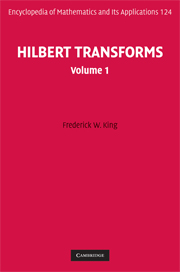Book contents
- Frontmatter
- Contents
- Preface
- List of symbols
- List of abbreviations
- 1 Introduction
- 2 Review of some background mathematics
- 3 Derivation of the Hilbert transform relations
- 4 Some basic properties of the Hilbert transform
- 5 Relationship between the Hilbert transform and some common transforms
- 6 The Hilbert transform of periodic functions
- 7 Inequalities for the Hilbert transform
- 8 Asymptotic behavior of the Hilbert transform
- 9 Hilbert transforms of some special functions
- 10 Hilbert transforms involving distributions
- 11 The finite Hilbert transform
- 12 Some singular integral equations
- 13 Discrete Hilbert transforms
- 14 Numerical evaluation of Hilbert transforms
- References
- Author index
- Subject index
13 - Discrete Hilbert transforms
Published online by Cambridge University Press: 04 May 2010
- Frontmatter
- Contents
- Preface
- List of symbols
- List of abbreviations
- 1 Introduction
- 2 Review of some background mathematics
- 3 Derivation of the Hilbert transform relations
- 4 Some basic properties of the Hilbert transform
- 5 Relationship between the Hilbert transform and some common transforms
- 6 The Hilbert transform of periodic functions
- 7 Inequalities for the Hilbert transform
- 8 Asymptotic behavior of the Hilbert transform
- 9 Hilbert transforms of some special functions
- 10 Hilbert transforms involving distributions
- 11 The finite Hilbert transform
- 12 Some singular integral equations
- 13 Discrete Hilbert transforms
- 14 Numerical evaluation of Hilbert transforms
- References
- Author index
- Subject index
Summary
Introduction
The terminology “discrete Hilbert transform” arises in two distinct contexts. The first occurrence is in the study of certain types of series with a denominator of the form n – m, where m is the summation index and n ∈ ℤ. The second area is in signal processing in engineering problems. The first part of this chapter is devoted to a discussion of the discrete Hilbert transform as it is commonly employed in engineering applications, and to some related topics including the discrete Fourier transform. The focus of the second part of the chapter is a discussion of the analog of the Hilbert transform on ℝ for a discrete series. Two related definitions are considered. The key inequality for the discrete Hilbert transform, called Hilbert's inequality, is established and a generalization given by M. Riesz is discussed. Since much of the data collected in both the physical sciences and engineering are discrete, the discrete Hilbert transform is a rather useful tool in these areas for the general analysis of this type of data.
The discrete Fourier transform
The discrete Fourier transform is commonly denoted in the scientific literature by the acronym DFT. The ideas that evolve for this transform provide a foundation for the development of the discrete Hilbert transform. The essential motivation behind thinking about discrete transforms is that experimental data are most frequently not taken in a continuous manner, but sampled at discrete time values. This is the fundamental feature of digital signal processing.
- Type
- Chapter
- Information
- Hilbert Transforms , pp. 637 - 683Publisher: Cambridge University PressPrint publication year: 2009

